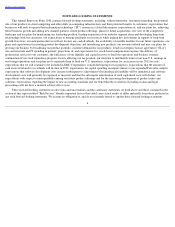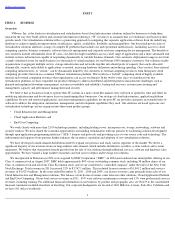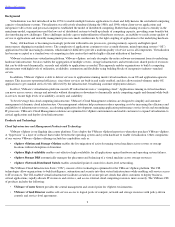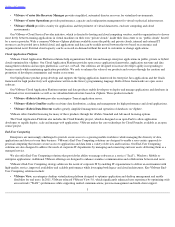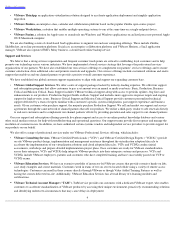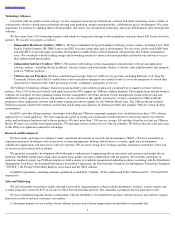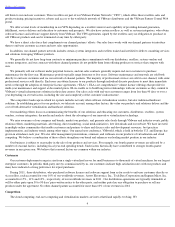VMware 2011 Annual Report Download - page 15
Download and view the complete annual report
Please find page 15 of the 2011 VMware annual report below. You can navigate through the pages in the report by either clicking on the pages listed below, or by using the keyword search tool below to find specific information within the annual report.
Table of Contents
Existing and future competitors may introduce products in the same markets we serve or intend to serve, and competing products may have
better performance, lower prices, better functionality and broader acceptance than our products. Our competitors may also add features to their
virtualization, end-user and cloud computing products similar to features that presently differentiate our product offerings from theirs. Many of
our current or potential competitors also have longer operating histories, greater name recognition, larger customer bases and significantly
greater financial, technical, sales, marketing and other resources than we do. This competition could result in increased pricing pressure and sales
and marketing expenses, thereby materially reducing our operating margins, and could harm our ability to increase, or cause us to lose, market
share. Increased competition also may prevent us from entering into or renewing service contracts on terms similar to those that we currently
offer and may cause the length of our sales cycle to increase. Some of our competitors and potential competitors supply a wide variety of
products to, and have well-established relationships with, our current and prospective end users. For example, small to medium sized businesses
and companies in emerging markets that are evaluating the adoption of virtualization-based technologies and solutions may be inclined to
consider Microsoft solutions because of their existing use of Windows and Office products. Some of these competitors have in the past and may
in the future take advantage of their existing relationships to engage in business practices that make our products less attractive to our end users.
Other competitors have limited or denied support for their applications running in VMware virtualization environments. These distribution,
licensing and support restrictions, as well as other business practices that may be adopted in the future by our competitors, could materially
impact our prospects regardless of the merits of our products. In addition, competitors with existing relationships with our current or prospective
end users could in the future integrate competitive capabilities into their existing products and make them available without additional charge.
For example, Oracle provides free server virtualization software intended to support Oracle and non-
Oracle applications, and Microsoft offers its
own server virtualization software packaged with its Windows Server product and has announced plans to offer built-in virtualization for future
releases of the client version of Windows. As a result, existing VMware customers may elect to use products that are perceived to be “free” or
“very low cost” instead of purchasing VMware products and services for certain applications where they do not believe that more advanced and
robust capabilities are required. Competitors may also leverage open source technologies to offer zero or low cost products capable of putting
pricing pressure on our own product offerings. By engaging in such business practices, our competitors can diminish competitive advantages we
may possess by incentivizing end users to choose products that lack some of the technical advantages of our own offerings.
We also face potential competition from our partners. For example, third parties currently selling our products could build and market their
own competing products and services or market competing products and services of third parties. If we are unable to compete effectively, our
growth and our ability to sell products at profitable margins could be materially and adversely affected.
The large majority of our revenues have come from our data center virtualization products including our flagship VMware vSphere product
line. Decreases in demand for our data center virtualization products could adversely affect our results of operations and financial condition.
In fiscal year 2011, approximately 90% of our license revenues were from our cloud infrastructure and management solutions with the
balance from our other solutions. Although we are continuing to develop other applications for our virtualization technology such as our cloud
computing and end-user computing products, we expect that our data center virtualization products and related enhancements and upgrades will
constitute a majority of our revenue for the foreseeable future. Declines and variability in demand for our data center virtualization products
could occur as a result of:
10
•
the ability to attract and preserve a large installed base of customers;
•
the ability to attract and preserve a large number of application developers to develop to a given cloud ecosystem;
• the ability to create and maintain partnering opportunities with hardware vendors, infrastructure software vendors and cloud service
providers;
•
the ability to develop robust indirect sales channels; and
•
the ability to attract and retain cloud, virtualization and systems experts as key employees.
•
improved products or product versions being offered by competitors in our markets;
•
competitive pricing pressures;
•
failure to release new or enhanced versions of our data center virtualization products on a timely basis, or at all;
•
technological change that we are unable to address with our data center virtualization products or that changes the way enterprises utilize
our products; and
•
general economic conditions.


